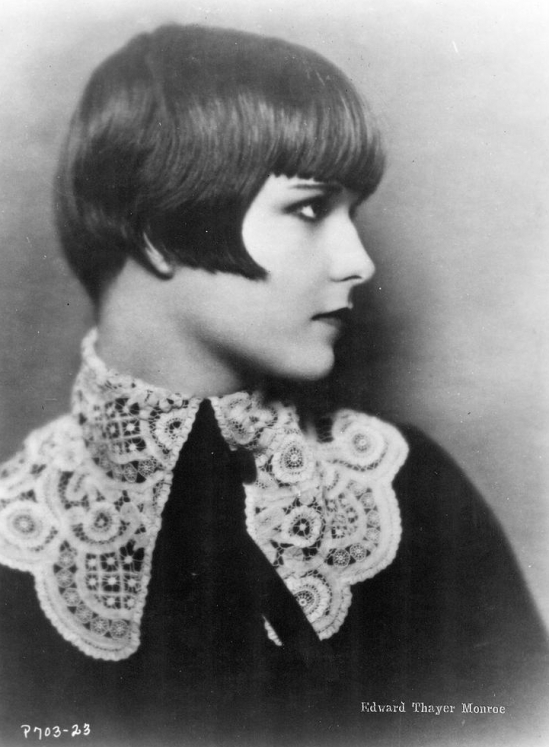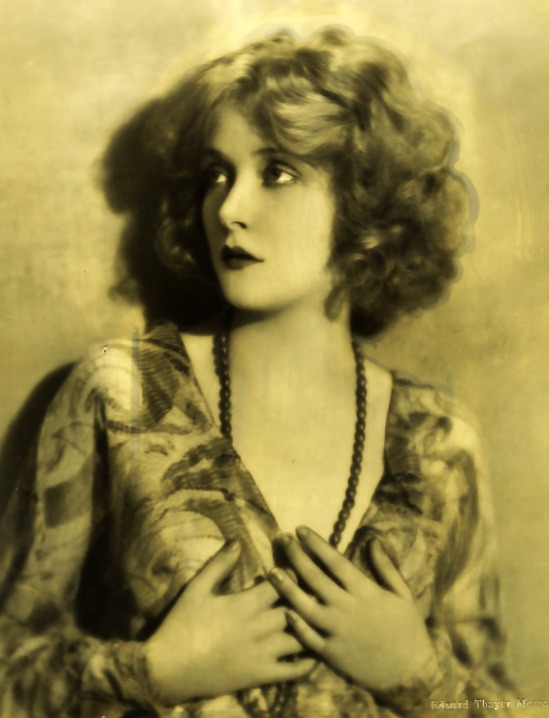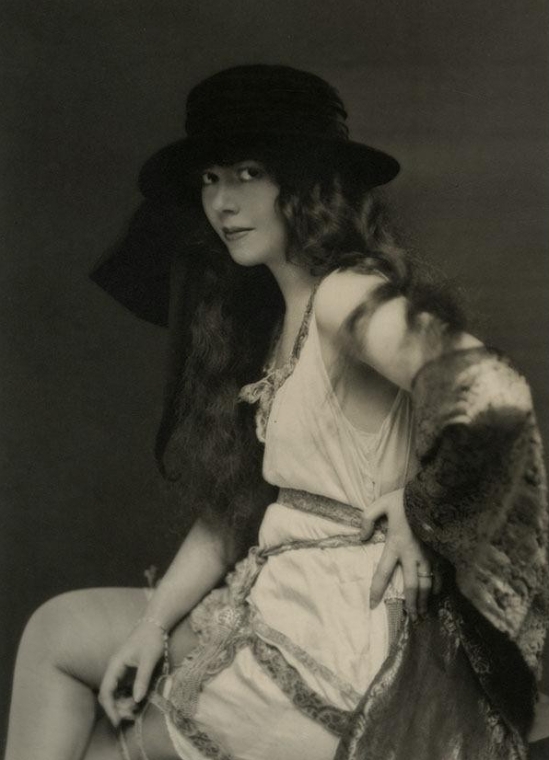
Portrait of Louise Brooks, 1925 via

Portrait of Louise Brooks, 1925 via

Portrait of Louise Brooks at home with her sister June, 1925 via

Portrait of Louise Brooks, 1925 via


Denishawn dance company founder Ruth St. Denis and husband Ted Shawn with a smattering of vestal virgins, Louise Brooks in the middle, 1920 via
Evening Clothes is a 1927 American silent comedy film directed by Luther Reed that was produced by Famous Players-Lasky and released by Paramount.
The film is based on the play L’homme en habit (The Man in Evening Clothes) by Andre Picard and Yves Mirande. Directed by Luther Reed, the film starred Adolphe Menjou, Virginia Valli, and Louise Brooks and is currently considered a lost film

Portrait of Louise Brooks as Fox Trot for Evening Clothes directed by Luther Reed, 1927 via

Portrait of Louise Brooks as Fox Trot for Evening Clothes directed by Luther Reed, 1927 via

Portrait of Louise Brooks as Fox Trot for Evening Clothes directed by Luther Reed, 1927 via
Diary of a Lost Girl is a 1929 silent film directed by Georg Wilhelm Pabst and starring the American silent star Louise Brooks. This was Brooks’ second and last film with Pabst, and like their prior collaboration (1929’s Pandora’s Box), it is considered a classic film. The film was based on the controversial and bestselling novel of the same name, Tagebuch einer Verlorenen (1905) by Margarete Böhme.
Thymian Henning (Louise Brooks), is the innocent, naive daughter of pharmacist Robert Henning. She is puzzled when their housekeeper, Elisabeth, leaves suddenly on the day of Thymian’s confirmation. It turns out that her father got Elisabeth pregnant. Elisabeth’s body is brought to the pharmacy later that day, an apparent suicide by drowning, upsetting Thymian.
Thymian’s father’s assistant Meinert, promises to explain it all to her late that night, but instead takes advantage of her; she gives birth to an illegitimate child. Though Thymian refuses to name the baby’s father, the relatives find out from her diary. They decide that the best solution is for her to marry Meinert. When she refuses because she does not love him, they give the baby to a midwife and send her to a strict reformatory for wayward girls run by a tyrannical woman and her tall, bald assistant.

Louise Brooks for Diary of a Lost Girl directed by George Wilhem Pabst, 1929 via

Louise Brooks for Diary of a Lost Girl directed by George Wilhem Pabst, 1929 via

Louise Brooks for Diary of a Lost Girl directed by George Wilhem Pabst, 1929 via
Flappers were a “new breed” of young Western women in the 1920s who wore short skirts, bobbed their hair, listened to jazz, and flaunted their disdain for what was then considered acceptable behavior. Flappers were seen as brash for wearing excessive makeup, drinking, treating sex in a casual manner, smoking, driving automobiles, and otherwise flouting social and sexual norms.
Flappers had their origins in the liberal period of the Roaring Twenties, the social, political turbulence and increased transatlantic cultural exchange that followed the end of World War I, as well as the export of American jazz culture to Europe.
Zelda Fitzgerald was an American socialite and novelist, and the wife of American author F. Scott Fitzgerald, who dubbed her “the first American Flapper”. She and Scott became the emblem of the Jazz Age, for which they are still celebrated via
Clara Bow epitomized the Roaring Twenties’ flapper. At only 25, she retired exhausted by repeated scandals about her presumed sexual life. Photo: Bow in a shiny strapless dress by Eugene Robert Richee, 1926 via
Coleen Moore was Bow´s “chief rival”. After Bow took the stage Moore gradually lost her momentum. In spring 1924 she made a good, but unsuccessful effort to top Bow in The Perfect Flapper, and soon after she dismissed the whole flapper vogue. Photo: Coleen Moore in “Why Be Good?”, 1929 via
Louise Brooks 1920. She was an American dancer and actress noted as an iconic symbol of the flapper, and for popularizing the bobbed haircut via
Gilda Gray, 1924. She was an American actress and dancer who popularized a dance called the “shimmy” which became fashionable in 1920s films and theater productions via
Tallulah Brockman, 1922. Bankhead was an American actress of the stage and screen, and a reputed libertine britannica.com
Anita Loos was an American screenwriter, playwright and author, best known for her blockbuster comic novel, Gentlemen Prefer Blondes first published in 1925. It was one of several famous novels published that year that chronicled the so-called Jazz Age – including Fitzgerald’s The Great Gatsby. Photo: Loos, on page 12 of the April 1922 Photoplay via
Eugene Robert Richee (b. 1896) began his career in the silent movie era. He got his job at Paramount in the late teens through his friend Clarence Sinclair Bull.
He started shooting stars while Donald Biddle Keyes was taking portraits in the gallery. When Keyes left Paramount, Richee took over, and for two decades he photographed the studio’s stars including Gloria Swanson, Rudolph Valentino, Claudette Colbert, Fredrick March, the Marx Brothers and Carole Lombard. Lombard so admired his work with Dietrich that she started posing in some of the same ways to get that ‘glamour mysterious’ look.
From 1925 to 1935 Richee took many photographs of Louise Brooks. Perhaps Richee’s most famous work is a 1928 portrait of Louise Brooks wearing a long string of pearls. Few photos capture better the zeitgeist of the Roaring ’20s. Simplicity is the hallmark of this photograph, along with masterful composition. Brooks stands, face in profile and wearing a long-sleeved black dress, against a black background, her face hands and pearls along illuminated. Her bob, with its razor-sharp line across the white skin of her jaw, was widely copied and became one of the last century’s most potent fashion statements.
Brook’s career had intermittent highs and lows, but she was one of Hollywood’s great portrait subjects and was never better served than by Richee (source).
Louise Brooks by Eugene Robert Richee, 1928 via
Louise Brooks by Eugene Robert Richee, 1928 via

Louise Brooks portrait by Eugene Robert Richee via
Portrait of Louise Brooks by Eugene Robert Richee, 1920s via
Portrait of Louise Brooks for The Canary Murder Case directed by Malcolm St. Clair and Frank Tuttle. Photo by Eugene Robert Richee, 1929 via
Portrait of Louise Brooks for The Canary Murder Case directed by Malcolm St. Clair and Frank Tuttle. Photo by Eugene Robert Richee, 1929 via

Clara Bow
Gloria Swanson in the Queen Kelly, 1929
Josephine baker´s Eton crop haircut

Louise Brooks short bobbed flapper hair
Marion Morehouse in Chanel. Photo by Edward Steichen, Vogue, 1926
Norma Shearer giving thanks for her amazing wardrobe collection in A Slave to Fashion, 1925

Bebe Daniels with an exotic animal, 1927
1920s icon Gilda Gray looking very glamorous

1920s girl with monocle

1920s style
The Canary Murder Case is a 1929 American Pre-Code crime-mystery film made by Paramount Pictures, directed by Malcolm St. Clair and Frank Tuttle. The screenplay was based on novel The Canary Murder Case by S.S. Van Dine. – Louise Brooks plays the role of Margaret Odell (The Canary), a scheming nightclub singer

Louise Brooks in The Canary Murder Case via

Louise Brooks in The Canary Murder Case 1929. Image by George P. Hommell via
Edward Thayer Monroe was born in Jamestown, New York, in 1890, into a family of photographers. His grandfather, Myron C. Monroe, pioneered wet-plate photography, recording Civil War scenes and shooting the first American images of Jenny Lind for P.T. Barnum. E.T. Monroe turned down the opportunity to attend Yale University, choosing a technical education instead. He received extensive practical training at a photographic processing plant in Syracuse and opened a home studio. In October 1914, the Dinturff Company of Syracuse hired him as “artistic portrait photographer” and his prints began circulating among magazine editors in the Northeast.

Louise Brooks by Edward Thayer Monroe via

Dorothy Stone by Edward Thayer Monroe via

Helen Lee Worthing by Edward Thayer Monroe, 1922 via

Anastasia Reilly (Ziegfeld Follies) by Edward Thayer Monroe via

Nita Naldi by Edward Thayer Monroe, 1925 via

Mary Nolan by Edward Thayer Monroe via

Ann Pennington by Edward Thayer Monroe via